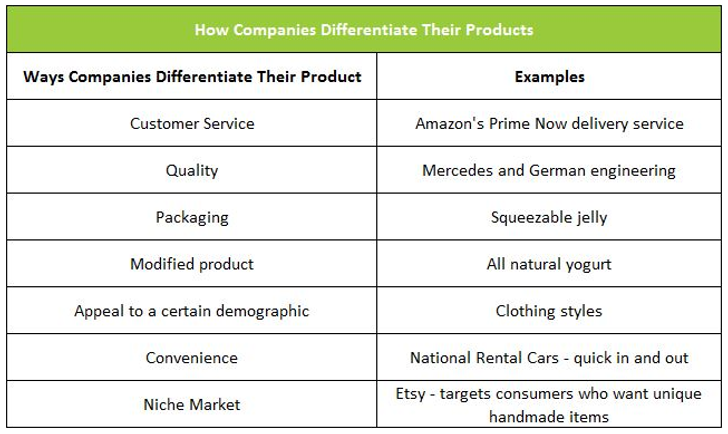Product Differentiation
View FREE Lessons!
Definition of Product Differentiation:
Product differentiation is a marketing strategy companies use to build brand loyalty and to make their products more attractive by emphasizing a difference between their products and their competitors' products.
Detailed Explanation:
Lemonade is lemonade, right? Wrong. Lemonade can be freshly squeezed, sweeter, frozen, pink, and perhaps many other variations. Companies strive to separate themselves from their competitors by providing some aspect of the good or service they sell that will build customer loyalty – thereby reducing price competition. For example, Country Time lemonade has been marketed as a "good old-fashioned lemonade" appealing to the memories of how quenching a glass of lemonade was on hot summer days before air conditioning.
Product differentiation may narrow the market some, but it builds brand loyalty by attracting customers who prefer the characteristic a company provides to the standard product. Ideally, sales would increase because that characteristic draws buyers from competitors. For example, assume your company is part of the $1 billion lemonade market, and your company has sales of $50 million. You believe offering pink lemonade will increase sales to $60 million, even though some lemonade drinkers are turned away by pink lemonade. Profits are further enhanced because many customers are willing to pay a higher price for the pink lemonade.
Consumers have different tastes. Companies strive to exploit these differences by distinguishing themselves from competing products. The differentiation may be in the quality of the product. Other companies may emphasize customer service. Still others may use its packaging to attract buyers. The table below lists some of the most common ways companies differentiate the goods and services they sell.

Consider the fast-food market. Assume you are in an area with many fast food vendors - perhaps the food court in a shopping mall. You have an urge for pizza. A vendor sells slices of pizza, but he charges twice as much as the restaurants selling chicken sandwiches, tacos, and hamburgers. Would you still buy the slice of pizza? Probably not, but even if your answer is, “Yes”, the line to purchase pizza is probably shorter because other consumers would substitute a chicken sandwich, taco, or hamburger for pizza. Those really craving pizza are willing to pay the higher price.
This scenario illustrates that these fast food companies have some pricing power. Unlike a monopoly, the managers are keenly aware of their competitors’ pricing. However, unlike a company in a perfectly competitive industry, they are not price takers. The goods these companies sell have downward-sloping demand curves. Managers understand sales will be lost if they raise their prices because some consumers will substitute a similar product at a lower price, but unlike an owner of a company in a perfectly competitive industry, they do not have to worry about losing
all their sales.
Product differentiation sets the monopolistic competition and oligopoly market structures apart from perfect competition and monopolies. Companies in a perfectly competitive industry produce a standardized product and cannot differentiate. (It would be hard for a shrimp fisherman to differentiate his shrimp.) Monopolies do not differentiate their products because they are the only producer of a good or service. Companies in industries with monopolistic competition and oligopoly market structures can use product differentiation to increase their profits. For companies in a monopolistic competition industry structure, differentiation results in increasing market share while charging more than if they were selling the same good or service in a perfectly competitive market. For oligopolies, product differentiation enables companies to compete in ways other than price, thereby limiting the damage of a price war with competitors.
Dig Deeper With These Free Lessons:
Market Structures Part II – Monopolistic Competition and Oligopoly
Market Structures Part I – Perfect Competition and Monopoly
Demand Changes – When Consumer Tastes Change
Supply and Demand – Producers and Consumers Reach Agreement
